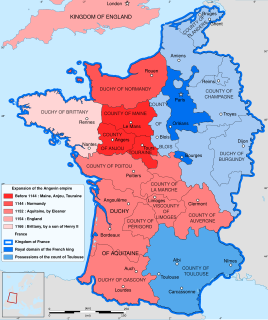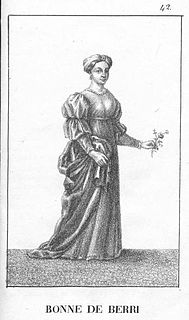Related Research Articles
Jean (John) de Bourbon, Duke of Bourbon, sometimes referred to as John the Good and The Scourge of the English, was a son of Charles I of Bourbon and Agnes of Burgundy. He was Duke of Bourbon and Auvergne from 1456 to his death.
Count of Guise and Duke of Guise were titles in the French nobility.
Duke of Nemours was a title in the Peerage of France. The name refers to Nemours in the Île-de-France region of north-central France.

The County of La Marche was a medieval French county, approximately corresponding to the modern département of Creuse.

Bernard VII, Count of Armagnac was Count of Armagnac and Constable of France. He was the son of John II and Jeanne de Périgord. He succeeded in Armagnac at the death of his brother, John III, in 1391. After prolonged fighting, he also became Count of Comminges in 1412.
Jacques d'Armagnac, duke of Nemours, was the son of Bernard d'Armagnac, count of Pardiac, and Eleanor of Bourbon-La Marche.

Charles du Maine (1414–1472) was a French prince of blood and an advisor to Charles VII of France, his brother-in-law, during the Hundred Years' War. He was the third son of Louis II, Duke of Anjou and King of Naples, and Yolande of Aragon.

James II of Bourbon-La Marche was the first son of John I, Count of La Marche and Catherine of Vendôme.
Bernard d'Armagnac, Count of Pardiac was a younger son of Bernard VII, Count of Armagnac and Bonne of Berry.

Louis d'Armagnac, Duke of Nemours, known for most of his life as the Count of Guise, was the third son of Jacques d'Armagnac, Duke of Nemours and Louise of Anjou.
Jean d'Armagnac, Duke of Nemours (1467–1500) was the son of Jacques d'Armagnac, Duke of Nemours and Louise of Anjou. His father's possessions were confiscated on his execution in 1477, but Jean was restored to Nemours and the family's other lands in 1484. He led a dissipated life, and his siblings sued him to prevent him from alienating the family lands to pay his debts. In 1489, he traded the viscounties of Carlat and Murat to Peter II, Duke of Bourbon for the county of l'Isle-Jourdain.
The League of the Public Weal was an alliance of feudal nobles organized in 1465 in defiance of the centralized authority of King Louis XI of France. It was masterminded by Charles the Bold, Count of Charolais, son of the Duke of Burgundy, with the king's brother Charles, Duke of Berry, as a figurehead.

Bonne of Berry was the daughter of John, Duke of Berry, and Joanna of Armagnac. Through her father, she was a granddaughter of John II of France.
John IV was a Count of Armagnac, Fézensac, and Rodez from 1418 to 1450. He was the son of Bernard VII of Armagnac, Count d' Armagnac, of Fézensac, Pardiac, and Rodez; and Bonne of Berry. John IV was involved in the intrigues related to the Hundred Years' War and in conflicts against the King of France.
Beatrice of Navarre (1392-1412/1415) was a daughter of Charles III of Navarre and his wife, Eleanor of Castile.
Peter of Luxembourg was a son of John of Luxembourg, Lord of Beauvoir, and his wife Marguerite of Enghien. His inheritance included the counties of Brienne, Conversano and Saint-Pol.
Castres-en-Albigenses was a dependence of the Viscount of Albi. The Viscounts of Albi granted Castres a city charter establishing a commune with the city, headed by consuls. During the Albigensian Crusade, the city quickly surrendered to Simon de Montfort, who gave it to his brother Guy de Montfort.

The House of Armagnac is a French noble house established in 961 by Bernard I, Count of Armagnac. It achieved its greatest importance in the fourteenth and fifteenth centuries.
Events from the year 1462 in France

Bibliothèque nationale de France fr. 113–116 is an Illuminated manuscript, now rebound as four manuscripts, commissioned by Jacques d'Armagnac, Duke of Nemours and executed by the workshop of Évrard d'Espinques around 1475. They contain the Lancelot-Grail cycle of romances, also known as the Vulgate Cycle, and constitute one of the most complete examples of Arthurian texts in prose, illuminated with 209 miniatures.
References
- ↑ Chisholm, Hugh, ed. (1911). . Encyclopædia Britannica . 19 (11th ed.). Cambridge University Press. pp. 369–370.